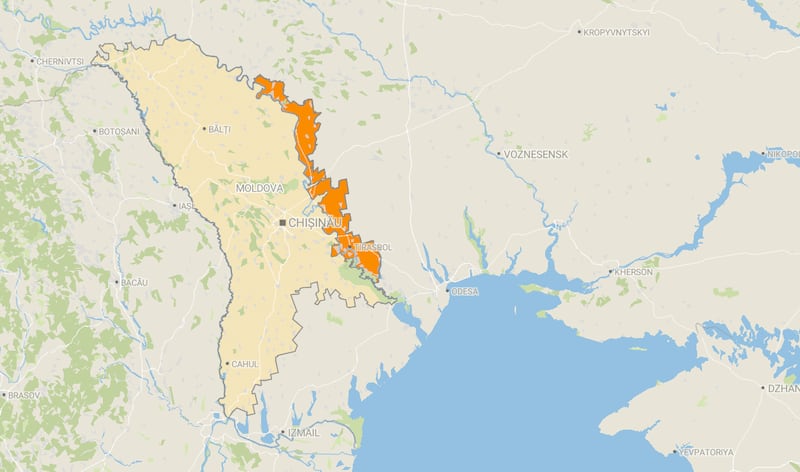In a quirk of history, February 24th, 2022, was the day that Ukraine and Moldova performed a long-planned test to disconnect their electricity from the Russian and Belarusian grids, part of a gradual process of moving away from Soviet-era systems and towards synchronising with the European Union.
Russia invaded the same day. Ukraine chose not to reconnect, leaving both countries abruptly cut off, operating as an electricity island. “Then was the pivotal point, in Brussels,” Moldova’s energy minister Victor Parlicov recalled in an interview in government offices in the capital Chisinau.
ENTSO-E, the pan-European network of electricity grids, chose to warp-speed the usual procedures and allow Ukraine and Moldova to connect to the European grid. For three weeks electricity engineers hauled through a process that usually takes years. They activated the 400 kilovolt overhead line in the border town of Vulcanesti, connecting Moldova to the grid of neighbouring Romania. Moldova’s connection to the EU went live on March 16th at 1:15pm local time.
The activation of that one electricity line had far broader geopolitical implications.
READ MORE
Since the early 1990s a long strip of Moldova’s borderlands with neighbouring Ukraine has been ruled by breakaway pro-Russian separatists as the self-declared republic of Transnistria.

Before the connection with Romania all but one of Moldova’s electricity lines ran through Transnistria. It meant that if those in charge there chose to they could disconnect and leave Moldova in the dark. This is no longer the case.
“Basically the Russians, through their proxies in Transnistria, lost their last major leverage to blackmail Chisinau, which was the electricity supply,” Parlicov put it.
Russian had long used energy to play hardball. After Moldova elected a pro-EU government in 2021, Russia’s state-owned Gazprom cut gas flows to the country and tripled its prices, forcing the declaration of a state of emergency in one of Europe’s poorest countries.
Following the invasion Moldovan energy utility Energocom established a workaround, setting up an alternative route to natural gas supplies. It began buying gas supplies from Athens, to be piped through Bulgaria, Romania, and Moldova into storage facilities in Ukraine.
Though Moldova now has its electricity connection to Romania as a backup, the bulk of its electricity is nevertheless still generated from Russian gas, which is piped into the country’s main power plant, the Cuciurgan power station, which is located within Transnistria.
The Transnistrian authorities receive the gas from Gazprom de facto for free, according to Parlicov, who sees this as the way Moscow maintains the breakaway republic. From their de facto capital Tiraspol, the Transnistrians then charge Moldova for the electricity the plant generates, generating funds for their public budget. Their ability to remain afloat economically, therefore, lies in Chisinau’s hands.
“This is an unstable equilibrium,” Parlicov says. A crisis “can be triggered not just by us. It can be triggered by the Russians, they can simply cease supply of gas to Transnistria. It can be triggered by Ukraine. Ukraine can simply not allow the transit of this gas.”
The invasion of Ukraine has altered other facts on the ground too. In the days after the invasion Kyiv closed all border crossings with Transnistria, cutting off the region’s trade to the east.
A large Transnistrian company found itself unable to export drink products to Russia as a result, The Irish Times was told. Another recently attended a large trade fair in the EU, hoping to increase its western-bound trade.
One small Transnistrian food producer told The Irish Times it was no longer able to buy packaging from Ukraine, so had switched to a French supplier. It was among two small Transnistrian businesses to say they were investing in registering their businesses in Chisinau and conforming to Moldovan regulations in the hopes of starting exports to Romania.
This is a microcosm of a larger reorientation that already took place in Moldova’s large wine sector. After Moscow banned imports of Georgian and Moldovan wine as the countries began to lean towards the EU, vineyards overhauled their prior reliance on exporting cheap sweet wine to the Russian market towards exporting higher quality vintages to the EU.
Ukraine’s decision to close its border is a definitive break with the policies of former pro-Russian administrations in Kyiv which in effect facilitated Transnistria by allowing their territory to act as a route to Russia.
The extent of the shift was illustrated when Ukrainian president Volodymyr Zelenskiy was peppered with questions by local reporters on a visit to Moldova last month as to whether Ukraine would militarily intervene to bring an end to the breakaway pro-Russian state.
“Ukraine can react and help only if there is a request from the authorities of the Republic of Moldova,” Zelenskiy replied, promising solidarity with Chisinau.
For the Moldovan government, already reeling from the challenge of taking in one of the largest influxes of Ukrainian refugees per capita, it’s vital that if there is a change in the status of Transnistria it is not a disorderly collapse.
“If the region collapses economically, the people will not disappear. There’s 300,000 people, most of them citizens of the Republic of Moldova. We need to somehow make sure that we can take care of them,” Parlicov said. “I don’t want to find ourselves in a situation where we have to address this issue, in a context where you call to Tiraspol and there’s no one picking up the phone.”
The Transnistrian authorities did not accept a request for an interview.




















